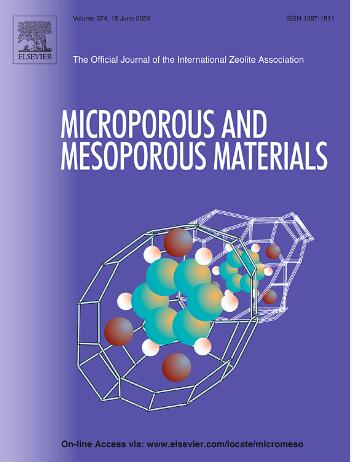Sulfated ZrO2 dispersed MCM-41 as an efficient catalyst in the production of polyoxymethylene dimethyl ether, an alternative for diesel: Brønsted acid sites key to its selective formation
IF 4.8
3区 材料科学
Q1 CHEMISTRY, APPLIED
引用次数: 0
Abstract
MCM-41-supported sulfated zirconia (SO42−/ZrO2/MCM-41) was identified as an efficient catalyst for the generation of polyoxymethylene dimethyl ether (PODE) from the polymerization of dimethoxymethane (DMM) with 1,3,5-trioxane (TOX). The type of acid sites involved and their surface conditions are deduced from NH3-TPD and pyridine-adsorbed IR techniques that revealed strong acidic site presence, which was responsible for its superior catalytic efficiency. Strong Brønsted acidic sites on the SO42−/ZrO2/MCM-41 catalyst surface led to a 72 % DMM conversion and a 42 % selectivity, with the desired chain length of PODE3-5. The IR and XPS analyses confirmed the existence of sulfate moieties on the catalyst surface. The experimental results showed stable catalytic activity up to four recycles without any leaching of the sulfate moiety.

硫酸ZrO2分散MCM-41作为生产聚氧亚甲基二甲醚(柴油的替代品)的有效催化剂:Brønsted酸位点是其选择性形成的关键
MCM-41负载的硫酸氧化锆(SO42−/ZrO2/MCM-41)是二甲氧基甲烷(DMM)与1,3,5-三氧环(TOX)聚合生成聚甲氧基二甲醚(PODE)的有效催化剂。根据NH3-TPD和吡啶吸附红外光谱技术推断出所涉及的酸位类型及其表面条件,发现存在强酸性位点,这是其优越的催化效率的原因。SO42−/ZrO2/MCM-41催化剂表面的强Brønsted酸性位点导致了72%的DMM转化率和42%的选择性,期望链长为PODE3-5。红外光谱和XPS分析证实了催化剂表面存在硫酸盐基团。实验结果表明,催化活性稳定,可循环4次,硫酸盐部分未发生浸出。
本文章由计算机程序翻译,如有差异,请以英文原文为准。
求助全文
约1分钟内获得全文
求助全文
来源期刊

Microporous and Mesoporous Materials
化学-材料科学:综合
CiteScore
10.70
自引率
5.80%
发文量
649
审稿时长
26 days
期刊介绍:
Microporous and Mesoporous Materials covers novel and significant aspects of porous solids classified as either microporous (pore size up to 2 nm) or mesoporous (pore size 2 to 50 nm). The porosity should have a specific impact on the material properties or application. Typical examples are zeolites and zeolite-like materials, pillared materials, clathrasils and clathrates, carbon molecular sieves, ordered mesoporous materials, organic/inorganic porous hybrid materials, or porous metal oxides. Both natural and synthetic porous materials are within the scope of the journal.
Topics which are particularly of interest include:
All aspects of natural microporous and mesoporous solids
The synthesis of crystalline or amorphous porous materials
The physico-chemical characterization of microporous and mesoporous solids, especially spectroscopic and microscopic
The modification of microporous and mesoporous solids, for example by ion exchange or solid-state reactions
All topics related to diffusion of mobile species in the pores of microporous and mesoporous materials
Adsorption (and other separation techniques) using microporous or mesoporous adsorbents
Catalysis by microporous and mesoporous materials
Host/guest interactions
Theoretical chemistry and modelling of host/guest interactions
All topics related to the application of microporous and mesoporous materials in industrial catalysis, separation technology, environmental protection, electrochemistry, membranes, sensors, optical devices, etc.
 求助内容:
求助内容: 应助结果提醒方式:
应助结果提醒方式:


